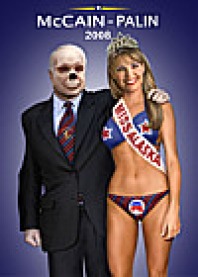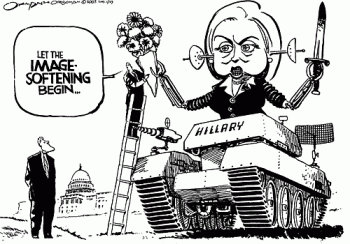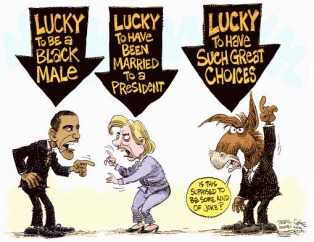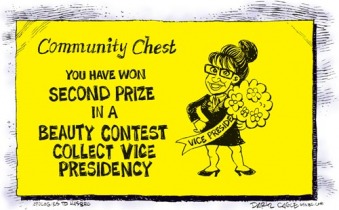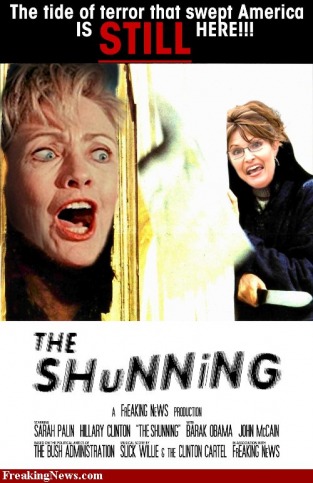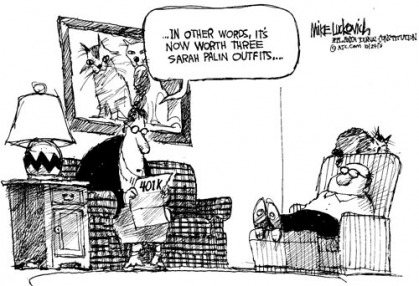Gender, Women & Femininity in Politics
An Opinion Piece by: Natalie Hansen Curtis
Gender is a significant issue in the portrayal of politicians throughout the spectrum of political cartoons. Women are characterized much differently than men, and are also held to a much different standard. In ‘Clinton, A Matter of Fair Media’ an article by Howard Kurz, Time’s editor Mark Halperin said Clinton is held to a different standard in every respect. “It’s not a level playing field,” he said (Kurz, paragraph 4).
Femininity is also a key aspect in political cartoons because of the stereotypical assumption of what it means to be a “woman." Much of America still holds the view that a woman should be passive, tender, caring, motherly and pretty. When a woman in power does not fit this mold, she is considered unfeminine and scrutinized by the public. However, if that same woman in power was to conform to this expected stereotype and adopt more feminine characteristics, she would then be considered weak and inferior to men.
In the article, “The Feminine Critique” by Lisa Belkin, she states that Catalyst, an organization that studies women in the workplace, found that “women who act in ways that are consistent with gender stereotypes — defined as focusing ‘on work relationships’ and expressing ‘concern for other people’s perspectives’ — are considered less competent. But if they act in ways that are seen as more ‘male’ — like ‘act assertively, focus on work task, display ambition’ — they are seen as ‘too tough’ and ‘unfeminine’ (Belkin, paragraph 4).”
There is also the cultural body type ideal which plays into the criticism of Hillary Clinton and Sarah Palin. The media portray the images of Clinton and Palin very differently in cartoons, as well as through picture editing and other visual representations. Clinton is almost always presented as hideous, ugly, old and fat with large hips and big thighs. This depiction makes viewers see her in a more negative light because she does fit the ideal feminine body type. One photo shows Kentucky Fried Chicken with a sign which compares her body parts to fried chicken, criticizing her thighs and breasts. If Hillary were a male candidate, she would most likely not be under this scrutiny of her body shape. In contrast, little was said of John McCain's physique as compared to the many derogatory names Hillary was called and the intense level of criticism she received for her "less than ideal" looks.
http://z.about.com/d/politicalhumor/1/0/N/N/hillary_kfcspecial.jpg
In contrast to Hillary, the image of Sarah Palin is much different because in cartoons, her image is portrayed like the ideal woman, with the perfect body, beautiful face, nice hair and attractive clothes. She is pictured almost as an opposite of Hillary because she holds the ideal outward appearance of an American female in the spotlight. Many photo-shopped pictures portray her on model-like, bikini bodies or in sexual, seductive poses. This objectifies her as just a body, instead of portraying her political experience, knowledge on topics or relevant issues. She is framed more as a side-kick, Barbie doll that draws attention to McCain's campaign through physical attractiveness, rather than political qualifications and capabilities.
http://www.freakingnews.com/images/contest_images/2099.jpg
In many political cartoons, Hillary Clinton is also depicted as being too determined, ambitious and mean, which then frames her as being unfeminine. The characteristic of being career driven also works negatively against her because she does not fit the stereotypical mold of housewife and mother that a lot of Americans expect. But while attempting to compete against the other male candidates and exposing her characteristics that enable her to succeed as an equally able presidential candidate, she is then framed in many inappropriate terms and criticized endlessly for being too masculine.
In the cartoon below, Hillary is shown in a very destructive, robotic, vicious light which is a negative depiction of her image. The cartoon also shows men trying to "soften her image" by handing her flowers so that she appeals more to the public as the gentle, meek, caring woman that society expects her to be because she is a female. It is my conclusion that if a man were to act similar to Hillary, these ambitious, powerful characteristics would not be displayed in this light, they would be seen as positive. It is only because she is a woman that she is portrayed so negatively.
http://content.cartoonbox.slate.com/?feature=003737e22e7ad592e7378459efaf1265
In another specific cartoon, Hillary is characterized as “lucky to have been married to a president." This statement gives the implication that she has gotten where she is based upon the success of her husband. In actuality, the name Bill Clinton brings about controversy, and her experience or “luckiness” from being first lady may account for part of her fame, but it also can account for part of the harsh criticism and attacks she has dealt with. Hillary Clinton was not handed her support and accomplishments on a silver platter; she earned her success through hard work, dedication and ambition.
It is my speculation that the gender and feminine criticism of Hillary is not based upon any fact or reality but rather the fear men have of women actually becoming intellectually able to compete with them. Since males are expected to be very competitive, it is the ultimate rejection to be brought down to the level of a girl. One common phrase boys grow up with is “you play like a girl." For men to think that women are equal or in reality, superior to them, they cannot bare it. As a resolution, men must then think of ways to demoralize, belittle and criticize the women who they feel threatened by, in order to make themselves feel superior once again.
But it is not just men who encourage this negative image of Hillary Clinton. Women who have grown up in homes where their mothers were treated as inferior to their fathers, or had mothers who were only stay-at-home moms with no careers, may also feel uncomfortable with the thought of having a woman rule the nation. By always having a father figure to control the home and make all the important decisions, children may develop the assumption that only men are leaders and decision makers while women are only nurturers and care-takers.
On the complete opposite end of the "feminism spectrum," Sarah Palin is depicted as the perfect image of beauty, motherhood and femininity, which in the political sense makes her unable to lead because she is too emotional, sensitive and weak. The stereotypical woman and motherly characterization also gives the impression that she is not qualified or powerful enough to compete in a dominantly male profession.
The cartoon below implies that Palin was chosen as Vice President because of her beauty, charisma and experience in beauty pageants and not for her political experience or qualifications. This was a widespread trend among cartoons, which focused on framing the fact that her attractive outward appearance is a main part of the reason she was chosen and also a reason many voters support her.
http://z.about.com/d/politicalhumor/1/0/X/G/2/sarah-pain-monopoly.jpg
The reality is that although Sarah Palin is very inexperienced, this characteristic has nothing to do with her gender or her outward appearance. Some cartoons merely use her feminine characteristics and beauty to magnify her lack of experience and relate it to the fact that she is just a “hockey mom- beauty queen," not a qualified politician.
Hillary Clinton and Sarah Palin are two very different women, framed from two opposite perspectives but they do have one thing in common, their gender. Due to this fact, they are both portrayed more negatively than the male politicians. This gender criticism portrays them as being unable to lead because women cannot possibly possess the qualities equal to the male candidates. As Belkin stated, whatever qualities are valued, women are seen as lacking them.
In the edited picture below, both female politicians are placed in a negative light, because the poster states that Clinton and Palin are the "tide of terror that swept America". This portrayal implies that women are an entity that should be feared. Even though Clinton and Palin are very different, it shows that in one sense, they are very simliar because they are both inferior, "frightening", females. Although America has "shunned" them from politics, they are still in the politcal scene and are not ready to give up.
http://www.freakingnews.com/The-Shunning-Pictures-54443.asp
It is my interpretation that the reality behind this media image is that men indeed are afraid and terrified of women leading the country. It has been common in the past for our nation to try and associate fear with people or cultures that they were actually prejudice against. For example, this spreading of fear occurred when Japanese-Americans were considered spies after the bombing of Pearl Harbor or since September 11 individuals who appeared to be Middle-Eastern are assumed to be terrorists. This was even a common tactic with McCain, Palin and Hillary targeting Obama as Muslim, hoping to instill fear in Americans so they would not vote for him. Luckily, Americans were smart enough to look deeper beneath his race or ethnicity when it came to electing Obama, but this tactic to associate fear with women in politics is yet another way Clinton and Palin are portrayed negatively in the minds of Americans.
Even though Clinton and Palin possess many opposite qualities, the media still find a way to take their gender and femininity, or lack thereof, and frame it in a negative way. If voters were to look at political cartoons with a critical eye, they would assess the portrayal and ask themselves, “Would these faults or characteristics be exemplified or criticized if this candidate was a male?”
An article in the New York Times by Healy and Micheal Lou addressed Palin’s $150,000-wardrobe and William F. B. O’Reilly, a Republican consultant in New York stated, “No one would blink if this was a male candidate buying Brooks Brothers suits (paragraph 14).” In the political cartoon below, Palin's wardrobe is referenced in comparison to the man's 401K which frames Palin as a hypocrite for advocating herself as an average American people can relate to, but then spending a third of this man's 401K on a few pieces of clothing.
With this fact of reality aside, we can compare this criticism to that of the other male politicians, who Healy said spend thousands of dollars on suits; purchases we never hear about. But even though John Edwards was criticized for spending $400 on his haircut and John McCain was exposed for owning many houses, these male candidates still did not receive the same level of criticism as Sarah Palin. This conclusion is made because if John McCain only had one house, nothing would be said, and if Kerry had his hair cut for a more reasonable price, nothing would be said but according to a Republican consultant, if the party had chosen not to purchase new clothes for Palin then “Saturday Night Live would be doing jokes where Governor Palin would be dressed in elk skin (Healy, paragraph 17).” Either way, Palin would still be criticized for her dress and outward appearance more than if she was a male.
http://z.about.com/d/politicalhumor/1/0/I/Q/2/palin-outfits-lk1024d.jpg
Another question we probably would not consider for male politicians like Barack Obama, is how they will be able to take care of her children and assume their responsibilities in office. Since Palin is a woman, and we hold these expectations of her, we assume she will either neglect her children, or neglect her duties as Vice President. In the minds of many Americans who have traditional cultural female expectations, a woman cannot be both a good mother and a good political leader.
These points also lead us to the pivotal question, would Hillary have gotten the Democratic nomination if she were male? We cannot determine that answer right now, but we can assume that she would not be so widely criticized for being “mean, or too ambitious, or assertive” because according to Belkin, these are stereotypical characteristics that are only accepted and expected of males.
According to the article "Second-Place Citizens" by Susan Fauldi, we live in a nation where 86 percent of the “political pipeline” is male, so women in power are definitely in the minority. The stories, framings and criticisms of females are almost always going to focus on their one, obvious, differentiating characteristic... their gender.
Perhaps if we were to take Sarah Palin and combine her with Hillary Clinton, we could create an all inclusive, intelligent, experienced, ambitious, sensitive, beautiful, hockey/career mom Superwoman-Politician that the media could not tear down and deem inferior to man. But alas, unfortunately in the country of America, ranked 22nd among the 30 developed nations in its proportion of female federal lawmakers (Fauldi), it seems that her feminine parts and XX chromosomes would still land her in second place, behind the stereotypical male. As Belkin said, “Women can’t win (paragraph 5).”

